[調査レポート] 脳インプラント市場規模は、2022年の72億580万米ドルから2030年には176億4765万米ドルに成長すると予測されており、2022年から2030年の間に11.8%のCAGRを記録すると予測されています。
市場洞察とアナリストの見解:
神経科学と神経技術は急速に進歩しており、パーキンソン病、アルツハイマー病、てんかんなどの神経疾患がより一般的になるにつれて、医学を新たな限界へと押し上げています。脳インプラントは、神経活動を修正し、正常な脳機能を回復することにより、潜在的な治療ソリューションを提供します。さらに、人々は脳インプラントの利点をより認識するようになりました。パーキンソン病の安全で実証された治療法としての深部脳刺激への依存が高まることで、脳インプラント市場に成長の機会が生まれます。脳関連障害の症状を効果的に緩和するために、記憶の改善、病気の治療、義肢コミュニケーションを支援する神経インプラントの導入と使用が増えることで、市場は今後数年間でさらに成長すると予想されます。
成長の原動力:
高齢者は加齢とともに、運動機能に影響を及ぼす神経疾患を発症する可能性があります。アルツハイマー病、てんかん、パーキンソン病(PD)、ジストニアは、高齢者人口に影響を与える最も一般的な神経疾患です。米国国勢調査局による2020年の人口統計によると、高齢者人口は5,580万人、つまり全国人口の16.8%に達し、2020年には国内のほぼ6人に1人が65歳以上でした。さらに、汎米保健機構(PAHO)のデータによると、ブラジルには60歳以上の人が約3,000万人(つまり、国内人口の13%)います。この年齢層の人口は、2030年までに約5,000万人(つまり、全人口の24%)に達すると予想されています。2021年8月にUpToDate Inc.が発表した記事によると、てんかんの発症率は加齢とともに上昇し、75歳以上の患者で最も高くなります。
米国やカナダなどの国では、高齢化人口の増加に伴い、運動障害や精神疾患の有病率が高くなっています。パーキンソン病財団によると、パーキンソン病の症状は平均年齢60歳でよく見られます。たとえば、米国では年間約9万人がパーキンソン病と診断されています。同財団はまた、パーキンソン病の発症率は加齢とともに増加すると述べています。米国では約100万人がパーキンソン病を患っており、その数は2030年までに120万人に達すると予想されています。2023年4月に発表された「アルツハイマー病:脳深部刺激療法は症状の緩和に役立つか?」と題された記事によると、世界中で約3,200万人がアルツハイマー病を患っています。ブライトフォーカス財団が2022年10月に発表したアルツハイマー病研究ファクトシートによると、2022年に米国で約50万人が新たにアルツハイマー病と診断されました。アルツハイマー病の発症率は加齢とともに増加します。65歳以上のアメリカ人約650万人がアルツハイマー病を患っており、その数は2050年までに1,270万人に達すると予想されています。2022年2月に発表された世界保健機関(WHO)の統計によると、約5,000万人がてんかんを患っており、てんかんは世界で最も一般的な神経疾患の1つです。
要件に合わせてレポートをカスタマイズする
このレポートの一部、国レベルの分析、Excelデータパックなど、あらゆるレポートを無料でカスタマイズできます。また、スタートアップや大学向けのお得なオファーや割引もご利用いただけます。
- このレポートの主要な市場動向を入手してください。この無料サンプルには、市場動向から見積もりや予測に至るまでのデータ分析が含まれます。
神経疾患の発生率の増加と高齢者人口の増加により、疾患の治療と管理のための脳インプラントの需要が高まっています。てんかんの場合、発作中に患者の体が薬物に対して示す治療反応が低く、手術に伴う成功率が低いため、深部脳刺激法(DBS)技術が治療に使用されています。ノースカロライナ大学チャペルヒル校の研究者は、DBSを使用して刺激できる新しいニューロンを脳内に生成したと主張しています。アルツハイマー病のDBSでは、心臓ペースメーカーに似た埋め込み型デバイスと、脳の円蓋領域に直接弱い電気パルスを送る2本の付属ワイヤを使用します。電気刺激により、脳の記憶回路が活性化され、その機能が強化されます。そのため、DBSや迷走神経刺激などの神経インプラントは、パーキンソン病やその他の神経疾患の患者の治療にますます使用されています。
レポートのセグメンテーションと範囲:
脳インプラント市場は、治療、用途、エンドユーザー、および地域に基づいてセグメント化されています。治療に基づいて、市場は深部脳刺激、脊髄刺激装置、迷走神経刺激装置、侵襲性および非侵襲性脳コンピューターインターフェース、発作に対する反応性神経刺激、聴性脳幹インプラント、および眼科補助器具/インプラントに分類されます。用途に基づいて、市場は慢性疼痛、パーキンソン病、アルツハイマー病、てんかん、本態性振戦、うつ病、ジストニア、筋萎縮性側索硬化症/脳卒中/脊髄損傷、および神経線維腫症2/蝸牛全骨化に分類されます。エンドユーザーの観点から、脳インプラント市場は病院と専門クリニック/神経センターに分かれています。脳インプラント市場は、地理に基づいて、北米(米国、カナダ、メキシコ)、ヨーロッパ(ドイツ、フランス、イタリア、英国、スペイン、その他のヨーロッパ)、アジア太平洋(オーストラリア、中国、日本、インド、韓国、その他のアジア太平洋)、中東およびアフリカ(南アフリカ、サウジアラビア、UAE、その他の中東およびアフリカ)、南米および中米(ブラジル、アルゼンチン、その他の南米および中米)に分類されています。
セグメント分析:
脳インプラント市場は、治療方法によって、深部脳刺激、脊髄刺激装置、迷走神経刺激装置、侵襲性および非侵襲性脳コンピューターインターフェース、発作に対する反応性神経刺激、聴性脳幹インプラント、眼科補助器具/インプラントに分類されます。脊髄刺激装置セグメントは、2022年に最大の市場シェアを占めました。ただし、侵襲性および非侵襲性脳コンピューターインターフェースセグメントは、2022年から2030年の間に市場で最も高いCAGRを記録すると予測されています。脊髄刺激(SCS)は、従来の方法では原因を完全に治療できない場合、または損傷を修復できない場合に、慢性疼痛の管理に役立ちます。この療法は、慢性疼痛に苦しむ患者の症状を緩和し、日常の機能を改善します。片側または両側の痛みを含む、体幹の慢性で難治性の痛みの管理に適応します。さらに、SCSは標的を絞った疼痛緩和にも役立ちます。 SCS デバイスにはさまざまな種類があり、患者が依存症になる可能性のあるオピオイドなどの他の種類の治療法の代替として使用できます。
国立脊髄損傷統計センターが2021年6月に発表した報告書によると、米国では脊髄損傷に罹患している人が約296,000人いると考えられています。脊髄疾患の症例が増加するにつれて、脊髄刺激装置の需要も高まる可能性があります。したがって、脊髄疾患と慢性腰痛の発生率の上昇と医療費の払い戻しの利用可能性が相まって、SCSセグメントの脳インプラント市場の成長に有利に働いています。
用途に基づいて、脳インプラント市場は、慢性疼痛、パーキンソン病、アルツハイマー病、てんかん、本態性振戦、うつ病、ジストニア、筋萎縮性側索硬化症/脳卒中/脊髄損傷、神経線維腫症2/蝸牛全骨化に分類されます。慢性疼痛セグメントは、2022年に最大の市場シェアを占めました。アルツハイマー病セグメントは、2022年から2030年の間に最高のCAGRを記録すると予想されています。慢性疼痛とは、傷害または病気の平均治癒時間を超えて持続する持続的または再発性疼痛を指し、通常は3〜6か月以上持続します。さまざまな基礎疾患に起因する可能性があり、身体のあらゆる部分に影響を及ぼす可能性があります。慢性疼痛は複雑で多面的な状態であり、人々の身体的および感情的な健康、生活の質、および日常の機能に大きな影響を与えます。慢性疼痛の管理は、薬物療法、理学療法、生活習慣の変更、心理的介入など、複数の治療法の組み合わせを伴うことが多いため、困難な場合があります。UCSF の推定によると、2020 年に米国では 4 人に 1 人が慢性疼痛を経験しており、その多くは治療に抵抗性でした。脊髄損傷、脳卒中後疼痛、幻肢痛、神経痛、その他の病気による疼痛を持つ人々は、治療の希望があまりなく、しばしば苦痛を経験しています。
脳インプラント技術は、従来の治療法では効果的にコントロールできない場合に、慢性疼痛をコントロールおよび緩和するための代替アプローチとして研究されてきました。DBSは、慢性疼痛管理における潜在的な有効性が研究されているタイプの脳インプラントです。2022年3月、国立衛生研究所は、慢性疼痛治療としての高度なDBSソリューションに対して、USCFワイル神経科学研究所の神経外科教授とスタッフに、総額756万ドルの5年間の助成金を授与しました。これは、NIHのHelping to End Addiction Long-Term(HEAL)イニシアチブからの4,000万ドル以上の価値がある10の助成金のうちの1つです。このように、慢性疼痛に関する研究への資金提供の増加は、この分野の脳インプラント市場を推進しています。
エンドユーザーに基づいて、脳インプラント市場は病院と専門クリニック/神経センターに分かれています。病院セグメントは2022年に大きな市場シェアを占め、2022年から2030年にかけてより高いCAGRで成長すると予想されています。病院は、複雑でありながら専門的な科学機器を使用して医療サービスを提供する複雑な組織です。病院は、現代医学の問題に対処するために訓練された専門家チームを雇用しています。彼らはすべて、健康を回復し維持するという共通の目標のために連携しています。専門的な医療施設として、病院には、脳インプラント介入を必要とする可能性のあるさまざまな神経疾患の診断、治療、および管理のための重要な体制があります。病院は、脳インプラントの適切な候補者の評価と選択を含む、術前および術後のケアを提供します。また、継続的な監視とプログラミングを促し、これらのインプラントが適切に機能していることを確認するためのフォローアップ訪問をスケジュールし、最終的にインプラント手術を受ける患者の転帰を最適化します。病院は専門知識の中心として機能し、神経科医、脳神経外科医、看護師、その他の医療専門家からなる多分野にわたるチームが集まり、脳インプラントを受けた患者に専門的なケアを提供するために協力しています。
病院は、脳インプラント機器に関する知識の向上、技術の改善、および用途の拡大を目的とした研究および臨床試験の実施において極めて重要な役割を果たしています。病院は教育およびトレーニング センターとして機能し、専門的なトレーニング プログラムと継続的な医学教育を通じて、医療従事者に脳インプラント分野の専門知識を高める機会を提供しています。
地域分析:
地理に基づいて、脳インプラント市場は主に北米、ヨーロッパ、アジア太平洋、中南米、中東およびアフリカに分かれています。北米は2022年に世界市場の大きなシェアを獲得しました。米国はこの地域で最大の市場シェアを占めました。米国での市場成長は、神経疾患の有病率の増加、研究開発活動の増加、脳インプラントの技術的進歩に起因しています。パーキンソン病財団によると、2020年に米国で93万人がパーキンソン病を患っており、その数は2030年までに120万人に増加すると予想されています。深部脳刺激装置(DBS)などの脳インプラントは、パーキンソン病の潜在的な治療オプションであることが証明されています。DBSデバイスは、パーキンソン病に伴う振戦の制御に効果的であることが観察されています。オレゴン健康科学大学(OSHU)脳研究所によると、米国の本態性振戦患者の約90%がDBS後に症状の中等度の緩和を経験しました。
技術の進歩と新製品の発売も、米国の脳インプラント市場の成長を牽引しています。2020年1月、アボットのInfinity DBSシステムは、PDの治療薬として米国食品医薬品局(FDA)の承認を取得しました。このシステムは、PDの症状に関連する脳の特定の領域(淡蒼球内側部)をターゲットにしています。
脳インプラント市場の地域別洞察
予測期間を通じて脳インプラント市場に影響を与える地域的な傾向と要因は、Insight Partners のアナリストによって徹底的に説明されています。このセクションでは、北米、ヨーロッパ、アジア太平洋、中東およびアフリカ、南米および中米にわたる脳インプラント市場のセグメントと地理についても説明します。

- 脳インプラント市場の地域別データを入手
脳インプラント市場レポートの範囲
| レポート属性 | 詳細 |
|---|---|
| 2022年の市場規模 | 72億1000万米ドル |
| 2030年までの市場規模 | 176.5億米ドル |
| 世界のCAGR(2022年 - 2030年) | 11.8% |
| 履歴データ | 2020-2021 |
| 予測期間 | 2023-2030 |
| 対象セグメント | 治療方法別
|
| 対象地域と国 | 北米
|
| 市場リーダーと主要企業プロフィール |
|
脳インプラント市場のプレーヤー密度:ビジネスダイナミクスへの影響を理解する
脳インプラント市場は、消費者の嗜好の変化、技術の進歩、製品の利点に対する認識の高まりなどの要因により、エンドユーザーの需要が高まり、急速に成長しています。需要が高まるにつれて、企業は提供を拡大し、消費者のニーズを満たすために革新し、新たなトレンドを活用し、市場の成長をさらに促進しています。
市場プレーヤー密度とは、特定の市場または業界内で活動している企業または会社の分布を指します。これは、特定の市場スペースに、その市場規模または総市場価値に対してどれだけの競合相手 (市場プレーヤー) が存在するかを示します。
脳インプラント市場で事業を展開している主要企業は次のとおりです。
- ボストン・サイエンティフィック
- メドトロニック
- ファンクショナルニューロモジュレーション株式会社
- フィッシャー・ウォレス・ラボラトリーズ社
- シンクロン株式会社
免責事項:上記の企業は、特定の順序でランク付けされていません。

- 脳インプラント市場のトップキープレーヤーの概要を入手
業界の発展と将来の機会:
世界の脳インプラント市場で活動する主要企業が行っているさまざまな取り組みを以下に示します。
- ボストン・サイエンティフィック社は、2023 年 6 月に Vercise Genus 脳深部刺激 (DBS) システムの一部として使用される Vercise Neural Navigator 5 ソフトウェアの米国 FDA 承認を取得しました。このソフトウェアは、パーキンソン病や本態性振戦の患者の治療を効率的にプログラミングするためのシンプルで実用的なデータを臨床医に提供します。
- 2021年1月、メドトロニック社は、パーキンソン病患者における適応型DBSの安全性と有効性を評価するために、ADAPT-PD(パーキンソン病の個別化治療のための適応型DBSアルゴリズム)への登録を発表しました。
競争環境と主要企業:
ボストン・サイエンティフィック・コーポレーション、メドトロニック、アボット(セント・ジュード・メディカル)、レニショー、ニューロペース、アレバ・ニューロセラピューティクス、ファンクショナル・ニューロモジュレーション、フィッシャー・ウォレス、ニューロスパイン、コルテック・ニューロ、ニューロ・スカイ、ニューラリンク、シンクロン、ブラックロック・ニューロテック、ブレインゲート、ウィスパー・AI、オンワード・メディカル、パラドロミクスは、脳インプラント市場の主要企業です。これらの企業は、世界中で高まる消費者の需要を満たすために、新しいハイテク製品の導入、既存製品の改良、地理的拡大に注力しています。
- 過去2年間の分析、基準年、CAGRによる予測(7年間)
- PEST分析とSWOT分析
- 市場規模価値/数量 - 世界、地域、国
- 業界と競争環境
- Excel データセット



Report Coverage
Revenue forecast, Company Analysis, Industry landscape, Growth factors, and Trends

Segment Covered
This text is related
to segments covered.

Regional Scope
North America, Europe, Asia Pacific, Middle East & Africa, South & Central America

Country Scope
This text is related
to country scope.
よくある質問
The brain implants market was valued at US$ 7,205.80 million in 2022.
The brain implants market is expected to be valued at US$ 17,647.65 million in 2030.
Spinal cord stimulation (SCS) can help manage chronic pain when the cause cannot be entirely treated using conventional methods or the injury cannot be repaired. This therapy offers relief and improves the daily functioning of patients suffering from chronic pain; it uses a mild electrical current to stimulate specific nerve fibers in the spinal cord. It is indicated for the management of chronic, intractable pain of the trunk, including unilateral or bilateral pain. Furthermore, SCS helps in targeted pain relief. The method can improve the overall quality of life and sleep, and reduce the need for pain medicines. SCS devices are available in different varieties that can be used as an alternative to other sorts of treatments such as opioids, to which patients can develop addiction.
Neuroscience and neurotechnology are advancing rapidly, pushing medical science to new limits, driving the growth of the market, as neurological diseases like Parkinson's, Alzheimer's, and epilepsy become more common. Brain implants offer potential therapeutic solutions by modifying neural activity and restoring normal brain function. In addition, people have become more aware of the advantages of brain implants, and positive research outcomes are favoring brain implants market growth. Growing reliance on deep brain stimulation as a safe and proven treatment for Parkinson's creates growth opportunities for the brain implants market. The industry is expected to experience further growth in the coming years as more and more neural implants are being used to help with memory, disease treatment, and prosthetic limb communication to effectively reduce the symptoms of brain-related disorders.
The brain implants market has major market players, including Boston Scientific Corp, Medtronic Plc, Functional Neuromodulation Ltd, Fisher Wallace Laboratories Inc., Synchron Inc., Blackrock Microsystems Inc, Renishaw Plc., Abbott Laboratories, Neurospine LLC, CorTec GmbH, BrainGate, Aleva Neurotherapeutics SA, NeuroSky Inc, Neuralink Corp, NeuroPace Inc., ONWARD Medical NV, and Paradromics Inc.
Key factors driving the market growth are surging prevalence of neurological disorders with increasing geriatric population and rising number of spinal cords injuries. However, high cost associated with brain implant devices and procedures hinders the market growth.
Trends and growth analysis reports related to Life Sciences : READ MORE..
The List of Companies - Brain Implants Market
- Boston Scientific Corp
- Medtronic Plc
- Functional Neuromodulation Ltd
- Fisher Wallace Laboratories Inc.
- Synchron Inc.
- Blackrock Microsystems Inc
- Renishaw Plc.
- Abbott Laboratories
- Neurospine LLC
- CorTec GmbH
The Insight Partners performs research in 4 major stages: Data Collection & Secondary Research, Primary Research, Data Analysis and Data Triangulation & Final Review.
- Data Collection and Secondary Research:
As a market research and consulting firm operating from a decade, we have published and advised several client across the globe. First step for any study will start with an assessment of currently available data and insights from existing reports. Further, historical and current market information is collected from Investor Presentations, Annual Reports, SEC Filings, etc., and other information related to company’s performance and market positioning are gathered from Paid Databases (Factiva, Hoovers, and Reuters) and various other publications available in public domain.
Several associations trade associates, technical forums, institutes, societies and organization are accessed to gain technical as well as market related insights through their publications such as research papers, blogs and press releases related to the studies are referred to get cues about the market. Further, white papers, journals, magazines, and other news articles published in last 3 years are scrutinized and analyzed to understand the current market trends.
- Primary Research:
The primarily interview analysis comprise of data obtained from industry participants interview and answers to survey questions gathered by in-house primary team.
For primary research, interviews are conducted with industry experts/CEOs/Marketing Managers/VPs/Subject Matter Experts from both demand and supply side to get a 360-degree view of the market. The primary team conducts several interviews based on the complexity of the markets to understand the various market trends and dynamics which makes research more credible and precise.
A typical research interview fulfils the following functions:
- Provides first-hand information on the market size, market trends, growth trends, competitive landscape, and outlook
- Validates and strengthens in-house secondary research findings
- Develops the analysis team’s expertise and market understanding
Primary research involves email interactions and telephone interviews for each market, category, segment, and sub-segment across geographies. The participants who typically take part in such a process include, but are not limited to:
- Industry participants: VPs, business development managers, market intelligence managers and national sales managers
- Outside experts: Valuation experts, research analysts and key opinion leaders specializing in the electronics and semiconductor industry.
Below is the breakup of our primary respondents by company, designation, and region:

Once we receive the confirmation from primary research sources or primary respondents, we finalize the base year market estimation and forecast the data as per the macroeconomic and microeconomic factors assessed during data collection.
- Data Analysis:
Once data is validated through both secondary as well as primary respondents, we finalize the market estimations by hypothesis formulation and factor analysis at regional and country level.
- Macro-Economic Factor Analysis:
We analyse macroeconomic indicators such the gross domestic product (GDP), increase in the demand for goods and services across industries, technological advancement, regional economic growth, governmental policies, the influence of COVID-19, PEST analysis, and other aspects. This analysis aids in setting benchmarks for various nations/regions and approximating market splits. Additionally, the general trend of the aforementioned components aid in determining the market's development possibilities.
- Country Level Data:
Various factors that are especially aligned to the country are taken into account to determine the market size for a certain area and country, including the presence of vendors, such as headquarters and offices, the country's GDP, demand patterns, and industry growth. To comprehend the market dynamics for the nation, a number of growth variables, inhibitors, application areas, and current market trends are researched. The aforementioned elements aid in determining the country's overall market's growth potential.
- Company Profile:
The “Table of Contents” is formulated by listing and analyzing more than 25 - 30 companies operating in the market ecosystem across geographies. However, we profile only 10 companies as a standard practice in our syndicate reports. These 10 companies comprise leading, emerging, and regional players. Nonetheless, our analysis is not restricted to the 10 listed companies, we also analyze other companies present in the market to develop a holistic view and understand the prevailing trends. The “Company Profiles” section in the report covers key facts, business description, products & services, financial information, SWOT analysis, and key developments. The financial information presented is extracted from the annual reports and official documents of the publicly listed companies. Upon collecting the information for the sections of respective companies, we verify them via various primary sources and then compile the data in respective company profiles. The company level information helps us in deriving the base number as well as in forecasting the market size.
- Developing Base Number:
Aggregation of sales statistics (2020-2022) and macro-economic factor, and other secondary and primary research insights are utilized to arrive at base number and related market shares for 2022. The data gaps are identified in this step and relevant market data is analyzed, collected from paid primary interviews or databases. On finalizing the base year market size, forecasts are developed on the basis of macro-economic, industry and market growth factors and company level analysis.
- Data Triangulation and Final Review:
The market findings and base year market size calculations are validated from supply as well as demand side. Demand side validations are based on macro-economic factor analysis and benchmarks for respective regions and countries. In case of supply side validations, revenues of major companies are estimated (in case not available) based on industry benchmark, approximate number of employees, product portfolio, and primary interviews revenues are gathered. Further revenue from target product/service segment is assessed to avoid overshooting of market statistics. In case of heavy deviations between supply and demand side values, all thes steps are repeated to achieve synchronization.
We follow an iterative model, wherein we share our research findings with Subject Matter Experts (SME’s) and Key Opinion Leaders (KOLs) until consensus view of the market is not formulated – this model negates any drastic deviation in the opinions of experts. Only validated and universally acceptable research findings are quoted in our reports.
We have important check points that we use to validate our research findings – which we call – data triangulation, where we validate the information, we generate from secondary sources with primary interviews and then we re-validate with our internal data bases and Subject matter experts. This comprehensive model enables us to deliver high quality, reliable data in shortest possible time.


 このレポートの無料サンプルを入手する
このレポートの無料サンプルを入手する